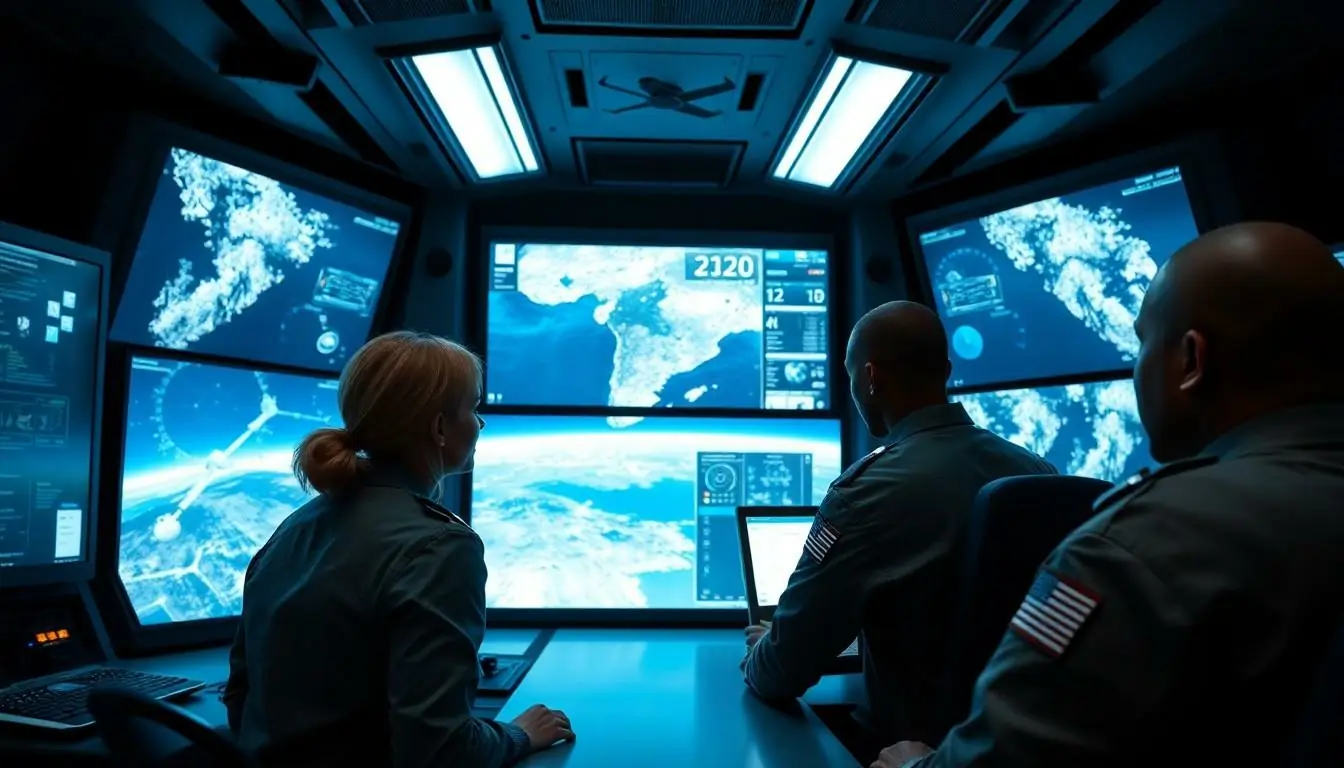In an age where your smartphone can do more than your first computer ever dreamed of, it’s no wonder that space force technology is blasting off into the stratosphere. Imagine a world where satellites don’t just orbit but actually communicate with each other like gossiping neighbors. This isn’t science fiction; it’s happening now, and it’s as cool as it sounds.
Table of Contents
ToggleOverview of Space Force Technology
Space Force technology encompasses various advanced systems designed to enhance national security in the domain of outer space. These systems include advanced satellites that provide unprecedented real-time communication capabilities. Current satellites engage in direct data exchange, streamlining operations and improving situational awareness.
Artificial intelligence plays a significant role in managing vast amounts of data collected from these satellites. This technology analyzes data rapidly, identifying patterns and trends that inform strategic decisions. Enhanced cybersecurity measures protect sensitive information and ensure the integrity of communications.
Spacecraft also incorporate cutting-edge propulsion systems, increasing efficiency and enabling longer missions. These advancements allow for more comprehensive exploration of celestial bodies and improved logistics for space missions.
The integration of various technologies contributes to a robust defense infrastructure in space. As satellite constellations grow, their interconnectedness improves global monitoring of threats and enhances response strategies.
Moreover, advances in materials science lead to the development of more resilient spacecraft, equipped to withstand the harsh conditions of space. These innovations not only improve longevity but also reduce mission costs.
Significant investments in satellite technology reflect a commitment to maintaining space as a secure operating environment. The capabilities of modern space force technology ensure that nations remain vigilant and prepared for any challenges in the ever-evolving realm of outer space.
Key Technologies in Space Force

Advancements in space force technology play a crucial role in national security. The following technologies are fundamental to enhancing capabilities and improving operations in outer space.
Satellite Systems
Modern satellite systems form the backbone of space force operations. These advanced satellites engage in real-time direct communication, allowing for swift data exchange. Several satellite constellations enhance global monitoring capabilities. Improved operational efficiency and awareness stem from their ability to work collaboratively. Spin-off technologies like autonomous navigation systems further increase performance in various conditions.
Advanced Communication Technologies
Next-generation communication technologies are vital for effective command and control. High-throughput satellites enable high-speed data transfer across vast distances. Quantum communication technologies offer unprecedented security levels by leveraging quantum mechanics. These advancements ensure that sensitive information remains protected from interceptions. Enhanced communication networks facilitate coordination among military and civilian assets, strengthening interoperability.
Missile Defense Systems
Innovative missile defense systems act as a crucial layer of protection. Advanced tracking systems utilize satellite data to detect potential threats early. Partnerships with ground-based missile systems enhance response times significantly. The integration of artificial intelligence allows for rapid assessment and decision-making during critical scenarios. These technologies ensure a robust defense posture against evolving threats from various adversaries.
Major Innovations and Developments
Major innovations are driving advancements in space force technology. These developments enhance operational capabilities and support national security in outer space.
Autonomous Systems
Autonomous systems represent a significant evolution in satellite technology. They enable spacecraft to operate without continuous human intervention, increasing responsiveness during missions. These systems process real-time data, allowing for immediate adjustments to trajectories or tasks based on surrounding conditions. Increased reliance on autonomy mitigates human error and supports complex mission profiles. Such capabilities improve the efficiency and safety of operations, enabling extended mission durations with minimal oversight.
Artificial Intelligence in Space Operations
Artificial intelligence plays a vital role in managing space operations. It analyzes vast streams of satellite data, producing actionable insights for decision-makers. This technology enhances threat detection and prediction models, supporting proactive measures against potential risks. AI also optimizes communication protocols, improving data transfer times and ensuring secure exchanges. Integration of AI systems boosts operational efficiency by automating mundane tasks, freeing personnel to focus on strategic initiatives. As AI tools evolve, their influence on space operations continues to grow, reflecting broader trends in technology.
Challenges Facing Space Force Technology
Operational challenges pose significant risks to space force technology. Cybersecurity threats increasingly jeopardize sensitive satellite data. It’s critical to maintain robust defenses against hacking attempts targeting communications and systems.
Budget constraints limit the scope of development and research initiatives. Resource allocation affects the speed of technological advancements and infrastructure improvements. Prioritization of missions becomes essential as different organizations compete for funding.
Technological integration presents unique difficulties. Approaches to combine various systems often lead to compatibility issues, slowing deployment and efficiency. Standardization across platforms remains necessary to ensure seamless operations.
Global competition complicates the landscape for space force technology. Nations accelerate their space capabilities, increasing the potential for conflict and the need for rapid adaptation. Continuous monitoring of international developments is essential to remain ahead.
The complexity of managing advanced satellite constellations creates operational hurdles. Coordination between numerous satellites requires sophisticated algorithms for real-time data sharing. Moreover, maintaining the functionality of these systems involves addressing environmental challenges, such as space debris.
Understanding the implications of emerging technologies also remains a challenge. Technologies such as artificial intelligence provide opportunities but introduce new variables that require careful management. Ensuring ethical considerations guides their application in military contexts is vital.
Overall, addressing these challenges necessitates a multifaceted approach. Collaboration between government agencies, private sectors, and international partners enhances the capability to tackle existing and emerging issues. Balancing innovation with prudent risk management will strengthen the framework for space force technology.
Future Trends in Space Force Technology
Emerging technologies are set to redefine space force capabilities. Artificial intelligence plays a pivotal role in optimizing satellite operations and data analysis. Real-time data processing enhances situational awareness, facilitating quicker decision-making. Autonomous systems significantly reduce reliance on human operators, increasing mission reliability.
High-throughput communication technologies enable faster data transfer. Quantum communication systems offer secure methods for transmitting sensitive information, further protecting national interests. Innovations in propulsion systems enhance spacecraft efficiency, allowing for extended missions and exploration capabilities.
Advanced materials science contributes to the development of more resilient spacecraft. This innovation reduces mission costs and improves durability against harsh space conditions. The integration of satellite constellations enhances global monitoring capabilities, allowing for precise threat detection and response.
Cybersecurity measures are evolving to protect against increasing digital threats. Robust strategies must address potential vulnerabilities in satellite infrastructure. Investment in research and development can propel advancements despite budgetary constraints.
International collaboration remains essential in optimizing space force technology. Joint ventures between governmental and private entities foster innovation and resource sharing. As competition among nations grows, adaptation and strategic planning become crucial.
Addressing challenges like space debris requires innovative solutions. Management of advanced satellite networks demands sophisticated algorithms capable of real-time data sharing. Collective efforts among countries and organizations will balance technological growth with security needs.
Space force technology is rapidly transforming the landscape of national security and defense. With advancements in satellite communication and artificial intelligence, nations are better equipped to monitor threats and respond swiftly. The integration of innovative propulsion systems and resilient materials is enhancing mission capabilities while reducing costs.
As challenges like cybersecurity threats and space debris loom, the focus on collaboration and innovative solutions is essential. The future of space operations hinges on the ability to adapt to emerging technologies and foster international partnerships. Continued investment in these areas is crucial for maintaining a secure and efficient presence in outer space.

